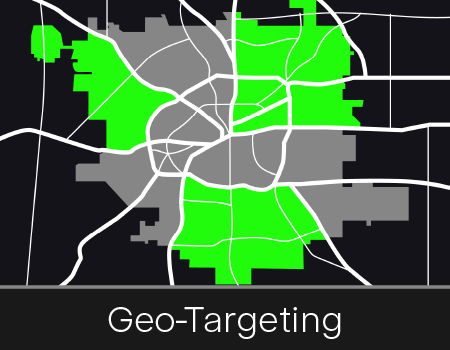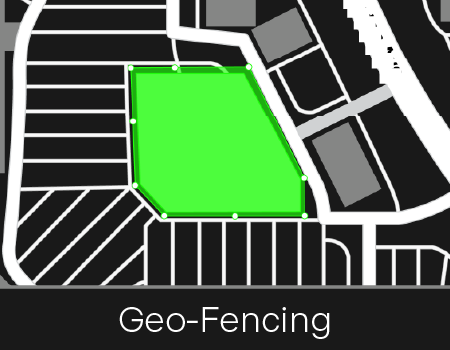What Are Geo-Targeted Ads? A Guide to Maximizing Local Ad Performance
Writer: Weston Wheeler
Date: September 30, 2025

Imagine your client’s campaign performing dramatically differently across regions. One market delivers strong conversions, while another underperforms, even with the same creative, budget, and targeting. The customer who finally converts says they saw the ad at just the right moment, right when they were near your client’s location.
That’s the power of geo-targeted advertising: delivering maximum relevance, precise targeting, and timely engagement to drive better performance.
Geo-targeting supports campaigns across QSRs, retail, local services, and multi-location brands, making it a core strategy for advertisers looking to reach high-intent audiences and improve ROI. But how does it work, and why are geo-targeted ads so effective? Let’s walk through everything you need to know about location-based targeting and how to launch campaigns that deliver transparent, performance-driven results.
WHAT IS GEO-TARGETING IN ADVERTISING?
Ever walked through your favorite clothing store, driven around a local neighborhood, or spent time in a specific area — only to see an ad for a nearby business later that day? That’s not a coincidence. That’s geo-targeted advertising in action.
Geo-targeting delivers ads to users based on their geographic location, providing marketers with highly localized precision. Location data comes from several sources, including:
- GPS
- IP address
- Wi-Fi signals
- Mobile towers
This approach works especially well for businesses that serve specific areas. By focusing campaigns through geo-targeting, marketing teams can ensure ads reach people who are most likely to engage, effectively improving performance and cutting waste.
HOW GEO-TARGETING ADVERTISING WORKS
Geo-targeted ads can be broad or specific, from city-level campaigns to street-level targeting. Here’s how it works:
- GPS-based targeting on mobile: Mobile devices with GPS capabilities precise location data, helping you reach users based on where they are right now.
- IP location targeting for desktop: IP addresses link to geographic locations, so you can target users based on where they’re browsing from.
- ZIP code targeting: Deliver ads to specific areas and make sure your campaigns only reach relevant audiences by layering on additional demographics.
- Location-based retargeting: Serve follow-up ads to website visitors based on their location, encouraging them to return and complete a purchase.
Whether running ads on mobile apps, display networks, in-room TVs, or social platforms, geo-advertising reduces wasted impressions and helps you reach people who will take action.
GEO-TARGETING VS. GEO-FENCING: WHAT’S THE DIFFERENCE?
 |  |
While the terms geo-targeting and geo-fencing are often used interchangeably, there are some distinct differences. Geo-fencing triggers immediate actions when someone enters a specific area, while geo-targeting offers more strategic, flexible targeting options.
Here’s a side-by-side comparison to illustrate their key differences:

Geo-fencing is ideal for real-time, location-triggered campaigns, while geo-targeting provides broader flexibility. By layering in behavioral data, geo-targeting can create more sophisticated campaigns that reach people when they’re most likely to convert.
BENEFITS OF GEO-TARGETED MARKETING
Geo-targeted ads focus your ad spend on people most likely to take action, boosting both campaign performance and ROI. Here are the benefits:
- Increased Relevance and Engagement
Location-aware ads naturally feel more relevant to users. When people see an ad for a nearby restaurant during lunch hour or get a retail promotion while shopping in the area, they’re more likely to engage. This relevance translates into higher click-through rates and stronger connections with your brand. - Improved Conversion Rates
Geo-targeted ads drive higher-quality traffic because they reach people who can take action. Someone seeing your store’s promotion while they’re nearby is far more likely to visit than someone hundreds of miles away. This proximity factor significantly improves conversion rates and reduces customer acquisition costs. - Efficient Budget Allocation
Instead of spreading your budget thinly across irrelevant markets, geo-targeting lets you concentrate your spend where it matters most. You can invest more heavily in high-performing locations and reduce waste in areas that don’t convert. This focused approach makes every dollar work harder. - Better Insights and Analytics
Geographic targeting provides detailed performance data by location, helping you understand which markets drive results and which need adjustment. You can see exactly how different cities, neighborhoods, or regions respond to your campaigns, then optimize your strategy based on real performance data rather than guesswork.
GEO-TARGETING EXAMPLES
Businesses across industries use geo-targeting to drive real results. Here are a few practical examples:
- Restaurants: A chain promotes happy hour deals to downtown office workers right before 5pm, tapping into local routines and immediate needs.
- Gyms: A franchise offers free trial passes to users who recently visited competing gyms nearby, capturing people actively seeking fitness solutions.
- Real estate agencies: Highlight local listings to buyers in specific neighborhoods, showing them properties that fit their location and budget.
- Resort casinos: Advertise exclusive weekend packages to travelers visiting nearby hotels, tourist attractions, or nightlife areas, making it easy for them to book a nearby experience.
- Retailers: Promote flash sales to shoppers within five miles of stores that have excess inventory, encouraging quick purchases.
- Dental practices: Target people who recently searched for dental services in the area, connecting them with trusted local care.
- Tourism companies: Share same-day tour discounts with travelers already visiting the region, turning a short trip into a spontaneous multi-day adventure.
- Landscaping businesses: Promote seasonal services to homeowners in affluent neighborhoods, aligning with specific property maintenance needs.
These examples show how geo-targeting adapts to different industries, campaign goals, and audiences while staying focused on relevance and local engagement.
CASE STUDY: HOW GEO-ADVERTISING HELPED KRISPY KREME DRIVE FOOT TRAFFIC

When Krispy Kreme opened its first store in Jamaica, Simpli.fi partnered to build awareness and increase foot traffic. They leveraged multiple geo-targeting strategies, including geo-fencing around the store, keyword search retargeting for people looking for donuts and coffee, and Conversion Zones to track visits.
The results:
- 237 total store visits
- $5.51 cost per visit (72% lower than the $20 target)
- 0.21% click-through rate (more than double the 0.10% goal)
By combining different geo-targeting methods, Krispy Kreme reached the right customers at the right time and drove real results.
TOOLS THAT HELP MARKETERS RUN GEO-TARGETED CAMPAIGNS
Running successful location-based campaigns requires a connected tech stack that supports every stage of execution and optimization. Simpli.fi’s platform brings together all the essential tools marketers need to run high-performing geo-targeted ad campaigns:
- Demand-Side Platforms (DSPs): Simpli.fi’s DSP provides built-in geo-targeting across mobile, display, Streaming TV, and more, enabling real-time bidding and precision targeting at scale.
- Location-based mobile targeting: Simpli.fi uses precise location data to deliver timely offers and promotions when users are near relevant businesses, making it a powerful asset for mobile-first strategies.
- Social media ad managers: Most platforms offer built-in geo-targeting tools, but Simpli.fi enhances these efforts with cross-channel audience extension and advanced targeting capabilities, helping to reach the same users beyond social, across mobile, CTV, and display.
- CRM data integrations: Combine customer data with location targeting to personalize campaigns based on purchase history, previous visits, and geographic behaviors, all within the Simpli.fi platform.
- Analytics and reporting: Simpli.fi provides performance insights at the ZIP code, DMA, or household level, so advertisers can optimize campaigns, reallocate budgets, and measure real ROI by location.
These components are enhanced by advanced features like radius targeting, custom mapping, cross-device retargeting, and real-time campaign adjustments, giving marketers the flexibility to improve campaigns as they run.
DRIVE BETTER RESULTS WITH SIMPLI.FI’S GEO-TARGETING SOLUTIONS
The core advantage of geographical targeting is simple: better ROI through precision. When you reach the right people, in the right place, at the right time, every dollar works harder and delivers measurable results.
Simpli.fi specializes in high-performing geo-targeted campaigns that go beyond basic location targeting. Our platform combines hyperlocal targeting with real-time data optimization and flexible audience building to drive campaign effectiveness.
What sets us apart is our addressable geo-fencing technology. Unlike standard geo-fencing, our Addressable Audience Curation tool uses over 3,000 data variables to build custom audiences in real-time, creating more sophisticated targeting that drives better performance.
We make geo-targeting work across all your campaigns through automated solutions, including:
- CTV advertising
- Mobile programmatic advertising
- Programmatic display advertising
- Programmatic video advertising
- Omnichannel campaigns
- Political advertising
- Digital Out-of-Home
Ready to maximize your relevance and multiply your results? Contact us today to learn how Simpli.fi can transform your geo-targeting strategy and deliver the transparent, performance-driven campaigns your clients expect.
 | Weston Wheeler
Sr. Content Marketing Manager | Simpli.fi Weston Wheeler is a strategic content marketing leader with roots in educational leadership and creative writing, fields that continue to shape his thoughtful, narrative-driven approach to brand storytelling. As Senior Manager of Content Marketing at Simpli.fi, he blends analytical insight with creative execution to craft compelling content that resonates across channels. With deep experience in digital advertising and a track record of success partnering with global agencies and brands, Weston endeavors to bring precision, empathy, and innovation to every project. |
Relevant Resources